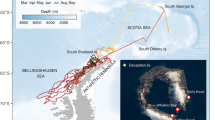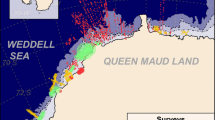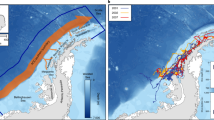Abstract
Antarctic fur seals (Arctocephalus gazella) are major secondary consumers in the Southern Ocean, placing them in potential competition with commercial fisheries and requiring research to understand their seasonal habitat use. Using the data obtained during 14 shipboard surveys sampled on a fixed grid (150 K km2) during mid- to late summer, I quantified the spatial distribution and intra-seasonal variability of fur seal sightings relative to distance to land and hydrographic boundaries. I test the hypothesis that fur seals display an increase in their at-sea abundance during mid- to late summer near the Antarctic Peninsula as they prepare to take up wintering grounds. I also test whether abundances of their potential prey, krill and myctophids, exhibit intra-seasonal variability. During midsummer, high-abundance areas are located near major breeding colonies; however, during late summer, there is an order-of-magnitude increase in fur seal abundance, coinciding with an increase in the number of high-abundance areas located in Bransfield Strait. Coincidently, abundance of Euphausia superba decreased and the myctophid Electrona antarctica increased between mid- and late-summer surveys. High-abundance areas of fur seals are not associated with the southern Antarctic Circumpolar Current front but are concentrated within 100 km from land, potentially indicating the location of haul out and important coastal habitat use areas. The dynamic increase in the number and location of high-abundance areas during late summer represents a considerable amount of mammalian predators entering the Antarctic Peninsula marine ecosystem. This information is important for understanding the seasonal impact of fur seals on regional marine food webs and their potential interaction with the autumn–winter krill fishery.






Similar content being viewed by others
References
Aguayo AL (1978) The present status of the Antarctic fur seal, Arctocephalus gazella at the South Shetland Islands. Polar Rec 19:167–176
Amos A (2001) A decade of oceanographic variability in summertime near Elephant Island, Antarctica. J Geophys Res 106:22401–22423
Atkinson A, Siegel V, Pakhomov EA, Rothery P, Loeb V, Ross RM, Quetin LB, Schmidt K, Fretwell P, Murphy EJ, Tarling GA, Fleming AH (2008) Oceanic circumpolar habitats of Antarctic krill. Mar Ecol Prog Ser 362:1–23
Barlow KE, Boyd IL, Croxall JP, Reid K, Staniland IJ, Brierley AS (2002) Are penguins and seals in competition for Antarctic krill at South Georgia? Mar Biol 140:205–213
Barrera-Oro E (2002) The role of fish in the Antarctic marine food web: differences between inshore and offshore waters in the southern Scotia Arc and west Antarctic Peninsula. Antarct Sci 14:293–309
Bengston JL, Ferm LM, Härkönen TJ, Stewart BS (1990) Abundance of Antarctic fur seals in the South Shetland Islands, Antarctica, during the 1986/87 austral summer. In: Kerry KR, Hempel G (eds) Antarctic ecosystems, ecological change and conservation. Springer, Berlin, pp 265–270
Bonadonna F, Lea M-A, Dehorter O, Guinet C (2001) Foraging ground fidelity and route-choice tactics of a marine predator: the Antarctic fur seal Arctocephalus gazella. Mar Ecol Prog Ser 223:287–297
Boyd IL (1993) Pup production and distribution of breeding Antarctic fur seals (Arctocephalus gazella) at South Georgia. Antarct Sci 5:17–24
Boyd IL (2002) Estimating food consumption of marine predators: Antarctic fur seals and macaroni penguins. J Appl Ecol 39:103–119
Boyd IL, McCafferty DJ, Reid K, Taylor R, Walker TR (1998) Dispersal of male and female Antarctic fur seals (Arctocephalus gazella). Can J Fish Aquat Sci 55:845–852
Boyd IL, Staniland IJ, Martin AR (2002) Distribution of foraging by female Antarctic fur seals. Mar Ecol Prog Ser 242:285–294
Brierley AS, Demer DA, Watkins JL, Hewitt RP (1999) Concordance of interannual fluctuations in acoustically estimated densities of Antarctic krill around South Georgia and Elephant Island: biological evidence of same-year teleconnections across the Scotia Sea. Mar Biol 134:675–681
Casaux R, Baroni A, Carlini A (1998) The diets of the Antarctic fur seal Arctocephalus gazella at Harmony Point, Nelson Island, South Shetland Islands. Polar Biol 20:424–428
Casaux R, Baroni A, Ramon A (2003) Diet of Antarctic fur seals Arctocephalus gazella at the Danco Coast, Antarctic Peninsula. Polar Biol 26:49–54
Casaux R, Bellizia L, Baroni A (2004) The diet of the Antarctic fur seal Arctocephalus gazella at Harmony Point, South Shetland Islands: evidence of opportunistic foraging on penguins? Polar Biol 27:59–65
Cherel Y, Kernaléguen L, Richard P, Guinet C (2009) Whisker isotopic signature depicts migration patterns and multi-year intra- and inter–inter-individual foraging strategies in fur seals. Biol Lett 5:830–832
Costa DP, Croxall JP, Duck CD (1989) Foraging energetics of Antarctic fur seals in relation to changes in prey availability. Ecology 70:596–606
Costa DP, Huckstadt LA, Crocker DE, McDonald BI, Goebel ME, Fedak MA (2010) Approaches to studying climatic change and its role on the habitat selection of Antarctic pinnipeds. Integr Comp Biol 50:1018–1030
Croll DA, Tershy BR (1998) Penguins, fur seals, and fishing: prey requirements and potential competition in the South Shetland Islands, Antarctica. Polar Biol 19:365–374
Croxall JP, Reid K, Prince PA (1999) Diet, provisioning and productivity responses of marine predators to difference in availability of Antarctic krill. Mar Ecol Prog Ser 177:115–131
Daneri GA (1996) Fish diet of the Antarctic fur seal, Arctocephalus gazella, in summer, at Stranger Point, King George Island, South Shetland Islands. Polar Biol 16:353–355
Daneri GA, Carlini AR, Hernandez CM, Harrington A (2005) The diet of Antarctic fur seals, Arctocephalus gazella, at King George Island, during the summer-autumn period. Polar Biol 28:329–333
Forcada J, Trathan PN, Reid K, Murphy EJ (2005) The effects of global climate variability in pup production of Antarctic fur seals. Ecology 86:2408–2417
Forcada J, Trathan PN, Boveng PL, Boyd IL, Burns JM, Costa DP, Fedak M, Rogers TL, Southwell CJ (2012) Responses of Antarctic pack-ice seals to environmental change and increasing krill fishing. Biol Conserv 149:40–50
Fraser WR, Pitman RL, Ainley DG (1989) Seabird and fur seal responses to vertically migrating winter krill swarms in Antarctic. Polar Biol 10:37–41
Greely TM, Gartner JV, Torres JJ (1999) Age and growth of Electrona antarctica (Pisces:Myctophidae), the dominant mesopelagic fish if the Southern Ocean. Mar Biol 133:145–158
Green K, Burton HR, Williams R (1989) The diet of Antarctic fur seals Arctocephalus gazella (Peters) during the breeding season at Heard Island. Antarct Sci 1:317–324
Guinet C, Dubroca L, Lea MA, Goldsworthy S, Cherel Y, Duhamel G, Bonadonna F, Donnay J-P (2001) Spatial distribution of foraging in female Antarctic fur seals Arctocephalus gazella in relation to oceanographic variables: a scale-dependent approach using geographic information systems. Mar Ecol Prog Ser 219:251–264
Hammond PS, Breggren P, Benke H, Borchers DL, Collet A, Heide-Jørgensen MP, Heimlich S, Hiby AR, Leopold MF, Øien N (2002) Abundance of harbour porpoise and other cetaceans in the North Sea and adjacent waters. J Appl Ecol 39:361–376
Hewitt RP, Watters G, Trathan PN, Croxall JP, Goebel ME, Ramm D, Reid K, Trivelpiece WZ, Watkins JL (2004) Options for allocating the precautionary catch limit of krill among small-scale management units in the Scotia Sea. CCAMLR Sci 11:81–97
Hill SL, Trathan PN, Agnew DJ (2009) The risk to fishery performance associated with spatially resolved management of Antarctic krill (Euphausia superba) harvesting. ICES J Mar Sci 66:2148–2154
Hunt GL, Heinemann D, Everson I (1992) Distributions and predator-prey interactions of macaroni penguins, Antarctic fur seals, and Antarctic krill near Bird Island, South Georgia. Mar Ecol Prog Ser 86:15–30
Jones CD, Ramm DC (2004) The commercial harvest of krill in the southwest Atlantic before and during the CCAMLR 2000 Survey. Deep-Sea Res II 51:1421–1434
Kawaguchi S, Nicol S, Takio K, Naganobu M (2006) Fishing ground selection in the Antarctic krill fishery: trends in patterns across years, seasons and nations. CCAMLR Sci 13:117–141
Kenyon KW, Wilke F (1953) Migration of the northern fur seal, Callorhinus ursinus. J Mamm 34:86–98
Kock K-H, Purves MG, Duhamel G (2006) Interactions between cetaceans and fisheries in the Southern Ocean. Polar Biol 29:379–388
Lea M-A, Guinet C, Cherel Y, Duhamel G, Dubroca L, Pruvost P, Hindell M (2006) Impacts of climatic anomalies on provisioning strategies of a Southern Ocean predator. Mar Ecol Prog Ser 310:77–94
Lea M-A, Guinet C, Cherel Y, Hindell M, Dubroca L, Thalmann S (2008) Colony-based foraging segregation by Antarctic fur seals at the Kerguelen Archipelago. Mar Ecol Prog Ser 358:273–287
Loeb VJ, Santora JA (2012) Population dynamics of Salpa thompsoni near the Antarctic Peninsula: growth rates and interannual variations in reproductive activity (1993–2009). Prog Oceanogr. doi:10.1016/j.pocean.2011.11.001
Loeb VJ, Hofmann EE, Klinck JM, Holm-Hansen O, White WB (2009) ENSO and variability of the Antarctic Peninsula marine ecosystem. Antarct Sci 21:135–148
Nicol S, Foster J, Kawaguchi S (2012) The fishery for Antarctic krill—recent developments. Fish Fish 13:30–40
Orsi AH, Whitworth T, Nowlin WD (1995) On the meridional extent and fronts of the Antarctic Circumpolar Current. Deep-Sea Res I 42:641–673
Payne MR (1977) Growth of a fur seal population. Philos Trans R Soc Lond B 279:67–79
Payne MR (1978) Population size and age determination in the Antarctic fur seal Arctocephalus gazella. Mamm Rev 8:67–73
Reid K (1995) The diet of Antarctic fur seals (Actocephalus gazella Peters 1875) during winter at South Georgia. Antarct Sci 7:241–249
Reid K, Sims M, White RW, Gillon K (2004) Spatial distribution of predator/prey interactions in the Scotia Sea: implications for measuring predator/fisheries overlap. Deep-Sea Res II 51:1383–1396
Reid K, Davis D, Staniland IJ (2006) Spatial and temporal variability in the fish diet of Antarctic fur seal (Arctocephalus gazella) in the Atlantic sector of the Southern Ocean. Can J Zool 84:1025–1037
Salwicka K, Rakusa-Suszczewski S (2002) Long-term monitoring of Antarctic pinnipeds in Admiralty Bay (South Shetlands, Antarctica). Acta Theriol 47:443–457
Santora JA (2012) Habitat use of hourglass dolphins near the South Shetland Islands, Antarctica. Polar Biol 35:801–806
Santora JA, Brown ET (2010) Spatial distribution patterns of southern bottlenose whales Hyperoodron planifrons near the South Shetland Islands. Mar Mamm Sci 26:960–968
Santora JA, Reiss CS (2011) Geospatial variability of krill and top predators within an Antarctic submarine canyon system. Mar Biol 158:2527–2540
Santora JA, Reiss CS, Cossio AC, Veit RR (2009) Interannual spatial variability of Antarctic krill (Euphausia superba) influences seabird foraging behavior near Elephant Island, Antarctica. Fish Oceanogr 18:20–35
Santora JA, Reiss CS, Loeb VJ, Veit RR (2010) Spatial association between hotspots of baleen whales and demographic patterns of Antarctic krill Euphausia superba suggests size-dependent predation. Mar Ecol Prog Ser 405:255–269
Santora JA, Sydeman WJ, Schroeder ID, Reiss CS, Wells BW, Cossio AC, Field JC, Loeb VJ (2012) Krill space: comparative assessment of mesoscale structure within polar and temperate marine ecosystems. ICES J Mar Sci 69:1317–1327
Siegel V, Piatkowski U (1990) Variability in the macrozooplankton community off the Antarctic Peninsula. Polar Biol 10:373–386
Smith RIL (1988) Destruction of Antarctic terrestrial ecosystems by a rapidly increasing fur seal population. Biol Conserv 45:55–72
Southwell C, Paxton CGM, Borchers D, Boveng P, de la Mare W (2008) Taking account of dependent species in management of the Southern Ocean krill fishery: estimating crabeater seal abundance off east Antarctica. J Appl Ecol 45:622–631
Staniland IJ, Robinson SL (2008) Segregation between the sexes: Antarctic fur seals Arctocephalus gazella, foraging at South Georgia. Anim Behav 75:1581–1590
Staniland IJ, Reid K, Boyd IL (2004) Comparing individual and spatial influences on foraging behavior in Antarctic fur seals Arctocephalus gazella. Mar Ecol Prog Ser 275:263–274
Staniland IJ, Gales N, Warren NL, Robinson SL, Goldsworthy SD, Casper RM (2010) Geographical variation in the behaviour of a central place forager: Antarctic fur seals foraging in contrasting environments. Mar Biol 157:2383–2396
Staniland IJ, Robinson SL, Silk JRD, Warren N, Trathan PN (2012) Winter distribution and haul-out behavior of female Antarctic fur seals from South Georgia. Mar Biol 159:291–301
Thompson AF, Heywood KJ, Thorpe SE, Renner AHH, Trasvina A (2009) Surface circulation at the tip of the Antarctic Peninsula from drifters. J Phys Oceanogr 39:3–26
Van Cise A (2008) AMLR 2007/2008 field season report. NOAA-TM-NMFS-SWFSC-427. 141 pp
Veit RR, Silverman ED, Everson I (1993) Aggregations patterns of pelagic predators and their principal prey, Antarctic krill, near South Georgia. J Anim Ecol 62:551–564
Waluda CM, Gregory S, Dunn MJ (2010) Long-term variability in the abundance of Antarctic fur seals Arctocephalus gazella at Signy Island, South Orkneys. Polar Biol 33:305–312
Whitehouse MJ, Veit RR (1994) Distribution and abundance of seabirds and fur seals near the Antarctic Peninsula during the austral winter, 1986. Polar Biol 14:325–330
Zar JH (1999) Biostatistical analysis, 4th edn. Prentice Hall, New Jersey
Acknowledgments
I greatly appreciate the effort and dedication of the many cruise participants of the US Antarctic Marine Living Resource (AMLR) program. Special thanks to Michael P. Force and Darci Lombard for their assistance in surveying seabirds and marine mammals, and Michael Goebel and Christian S. Reiss for valuable discussion. The feedback from three anonymous reviewers and the editor greatly improved this paper. This research was supported by AMLR contracts to J. A. Santora and NSF-OPP Grants (9983751, 0337648) to R. R. Veit.
Author information
Authors and Affiliations
Corresponding author
Additional information
Communicated by A. Atkinson.
Electronic supplementary material
Below is the link to the electronic supplementary material.
Rights and permissions
About this article
Cite this article
Santora, J.A. Dynamic intra-seasonal habitat use by Antarctic fur seals suggests migratory hotspots near the Antarctic Peninsula. Mar Biol 160, 1383–1393 (2013). https://doi.org/10.1007/s00227-013-2190-z
Received:
Accepted:
Published:
Issue Date:
DOI: https://doi.org/10.1007/s00227-013-2190-z




